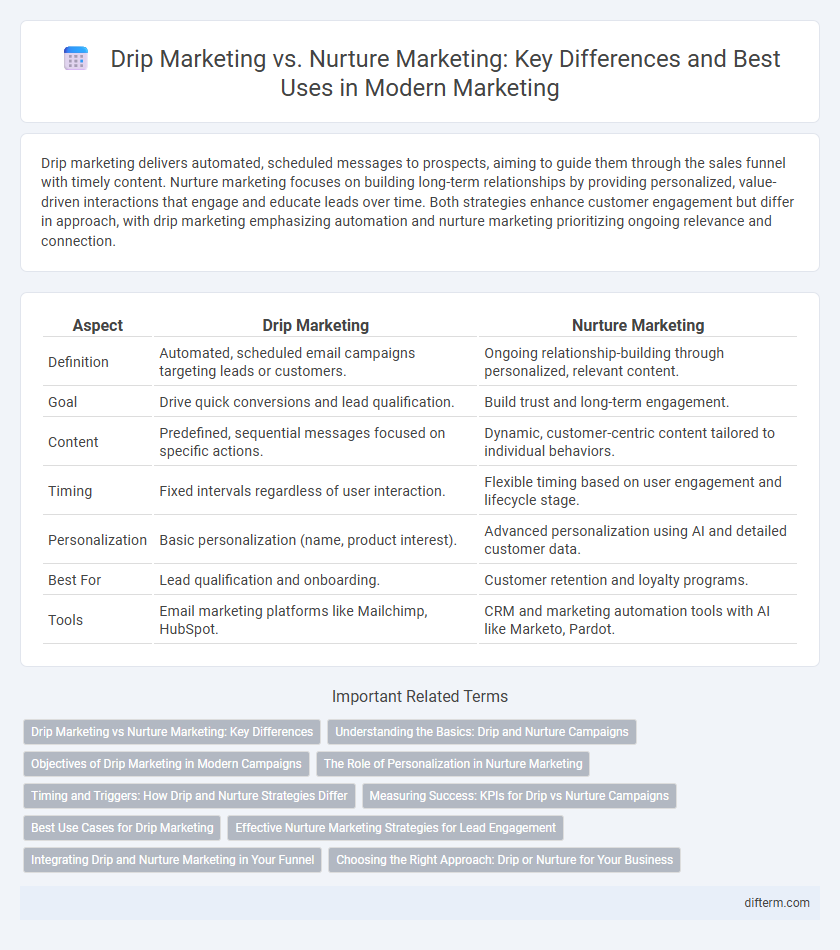Drip marketing delivers automated, scheduled messages to prospects, aiming to guide them through the sales funnel with timely content. Nurture marketing focuses on building long-term relationships by providing personalized, value-driven interactions that engage and educate leads over time. Both strategies enhance customer engagement but differ in approach, with drip marketing emphasizing automation and nurture marketing prioritizing ongoing relevance and connection.
Table of Comparison
| Aspect | Drip Marketing | Nurture Marketing |
|---|---|---|
| Definition | Automated, scheduled email campaigns targeting leads or customers. | Ongoing relationship-building through personalized, relevant content. |
| Goal | Drive quick conversions and lead qualification. | Build trust and long-term engagement. |
| Content | Predefined, sequential messages focused on specific actions. | Dynamic, customer-centric content tailored to individual behaviors. |
| Timing | Fixed intervals regardless of user interaction. | Flexible timing based on user engagement and lifecycle stage. |
| Personalization | Basic personalization (name, product interest). | Advanced personalization using AI and detailed customer data. |
| Best For | Lead qualification and onboarding. | Customer retention and loyalty programs. |
| Tools | Email marketing platforms like Mailchimp, HubSpot. | CRM and marketing automation tools with AI like Marketo, Pardot. |
Drip Marketing vs Nurture Marketing: Key Differences
Drip marketing delivers targeted, automated messages at specific intervals to engage leads and drive conversions, while nurture marketing emphasizes building long-term relationships through personalized content and ongoing interaction. Drip campaigns focus on timed sequences based on user actions, whereas nurture marketing adapts to evolving customer behaviors and preferences. Understanding these key differences helps marketers tailor strategies for lead acquisition versus customer retention.
Understanding the Basics: Drip and Nurture Campaigns
Drip marketing automates a series of pre-scheduled messages to guide prospects through the sales funnel, ensuring consistent communication over time. Nurture marketing focuses on building long-term relationships by delivering personalized content based on user behavior and engagement signals. Both strategies aim to increase conversions, but nurture marketing emphasizes adapting messages dynamically to the prospect's needs.
Objectives of Drip Marketing in Modern Campaigns
Drip marketing aims to deliver timely, automated messages to leads or customers, guiding them through the sales funnel with personalized content that increases engagement and conversion rates. It focuses on maintaining consistent communication, nurturing prospects gradually to build trust and move them closer to purchase decisions. The primary objective is to optimize lead nurturing efficiency by leveraging data-driven triggers and segmentation for targeted messaging in modern campaigns.
The Role of Personalization in Nurture Marketing
Personalization in nurture marketing tailors content to individual customer preferences and behaviors, increasing engagement and conversion rates. Utilizing data-driven insights, marketers deliver relevant messages that address specific needs throughout the buyer's journey. This targeted approach fosters stronger relationships and enhances customer lifetime value compared to generic drip marketing campaigns.
Timing and Triggers: How Drip and Nurture Strategies Differ
Drip marketing uses pre-scheduled timing to deliver a series of automated messages regardless of recipient behavior, ensuring consistent communication over a fixed period. Nurture marketing relies on dynamic, behavior-triggered interactions that respond to user actions, allowing personalized and timely engagement. This fundamental difference in timing and triggers enables drip marketing to maintain routine outreach while nurture marketing adapts fluidly to prospects' evolving needs.
Measuring Success: KPIs for Drip vs Nurture Campaigns
Drip marketing success is often measured by KPIs such as open rates, click-through rates, and conversion rates tied to specific, time-triggered emails, reflecting immediate engagement and sales impact. Nurture marketing emphasizes long-term metrics like lead quality scores, customer lifetime value (CLV), and engagement depth across multiple touchpoints to evaluate relationship growth and brand loyalty. Comparing these KPIs helps marketers align campaign goals with buyer journey stages for optimized ROI.
Best Use Cases for Drip Marketing
Drip marketing is most effective for onboarding new customers by delivering timely, automated messages that guide them through the initial stages of the buyer's journey. It excels in lead qualification by gradually providing information to gauge interest and readiness to purchase. This approach also works well for re-engagement campaigns, where consistent, spaced communication rekindles customer interest without overwhelming the audience.
Effective Nurture Marketing Strategies for Lead Engagement
Effective nurture marketing strategies for lead engagement prioritize personalized content delivery based on buyer personas and behavior tracking, ensuring messages resonate with individual needs and stages in the sales funnel. Utilizing multi-channel campaigns that combine email, social media, and retargeting ads enhances touchpoints and brand recall, significantly improving conversion rates. Integrating marketing automation tools enables precise timing and segmentation, fostering continuous relationship-building and accelerating lead qualification.
Integrating Drip and Nurture Marketing in Your Funnel
Integrating drip marketing and nurture marketing in your funnel enhances lead engagement by delivering timely, personalized content that guides prospects through each stage of the buyer journey. Drip marketing automates targeted messages based on user actions or timelines, while nurture marketing builds deeper relationships through valuable, relevant interactions. Combining both strategies increases conversion rates and customer lifetime value by maintaining consistent communication tailored to evolving audience behaviors.
Choosing the Right Approach: Drip or Nurture for Your Business
Drip marketing delivers automated, scheduled messages to leads based on specific timelines, ideal for straightforward, time-sensitive campaigns that require consistent touchpoints. Nurture marketing focuses on personalized, relationship-driven communication, tailored to the lead's behavior and engagement, fostering deeper connections and long-term conversion. Selecting the right approach depends on business goals: use drip marketing for structured lead progression and nurture marketing for customized, value-focused interactions that build trust.
drip marketing vs nurture marketing Infographic

 difterm.com
difterm.com